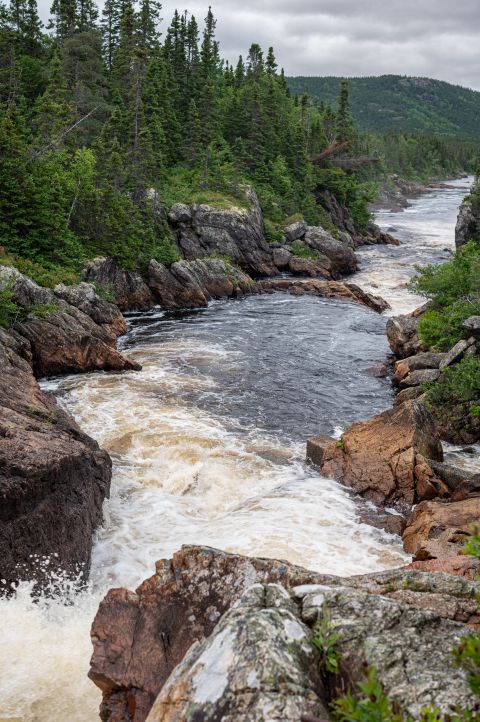
Subscribe & stay up-to-date with ASF

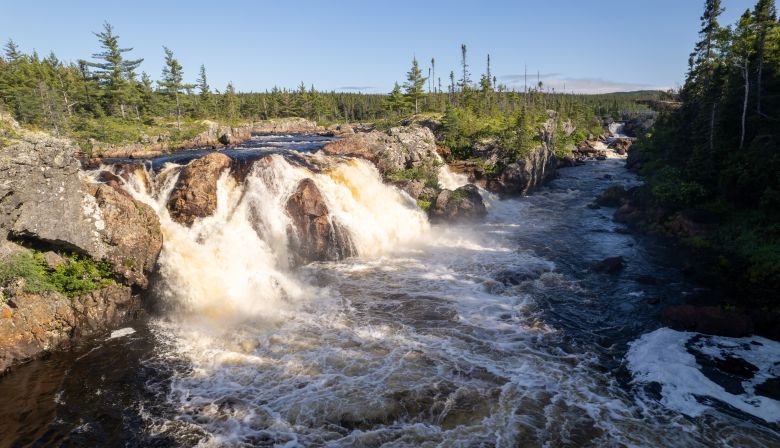
“Keep a sharp eye, me buddy.” – Don Ivany
After an enlightening few days on the Avalon Peninsula, I was ready to unravel the stories woven into the picturesque landscapes of Newfoundland’s west coast. However, I’d made a commitment to Kris Hunter, ASF’s Wild Salmon Watersheds Program Director: collect some visuals and narratives for our marketing and website while we were both in the region. One of the pilot sites for ASF’s Wild Salmon Watersheds program is the Terra Nova River. Kris was visiting to work with the dedicated individuals from The Freshwater Alexander Bays Ecosystem Corporation (FABEC).
I was met at the Terra Nova by an assembly of familiar faces. Among them, ASF’s Newfoundland and Labrador Program Director, Don Ivany, and Kris. Matt Schumacher, a Ph.D. student in environemntal science at MUN, who was there to learn about the watershed for his research into watershed modelling, had taken charge of our dinner. We feasted on burgers and potato salad, washing it down with some chilled beers as planned out the trip’s activities. John Baird, FABEC president, was kind to show up with a large pot of fresh, local mussels just as we were finishing our burgers. Full to the brim, I had only one option – keep eating.
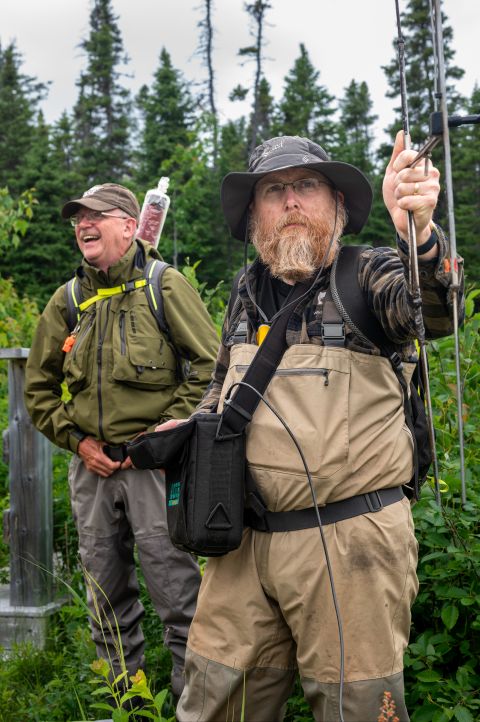
I was under the illusion that my stint here would be brief—a couple of days spent capturing drone footage and images before continuing west. However, over dinner, Kris shattered that illusion. He revealed that we would be heading upriver the next day to visit a fish ladder installed around a waterfall years ago. The mission was twofold: tally the salmon navigating through the ladder and try to catch and tag some for tracking purposes. The following day, we would embark on a multi-day canoe trip with FABEC to the upper stretches of the Terra Nova River. There, we would carry on with the tracking and conduct some maintenance work on their remote tracking station. Kris didn’t present this as a query, and I was grateful for his certainty that my response would be positive.
Come the next day, Kris, John Lane (a FABEC employee), and I piled into John’s square-tail canoe, fitted with a 2.3 horsepower outboard. Launching from the highway bridge, we began our upstream journey. The sun graced my face, and with a fishing rod in my pack, I was the picture of contentment. My first true immersion in Newfoundland’s wilderness was underway, and I was buzzing with anticipation.
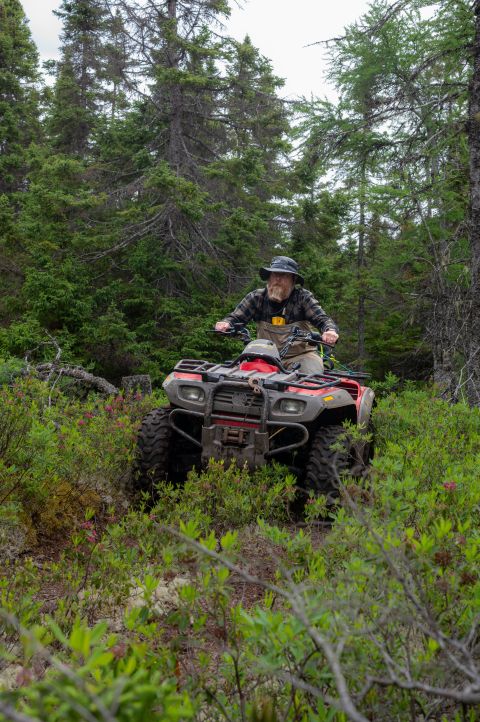
Around an hour into our expedition, we traded the gentle sway of water for the thrill of land. Leaping onto a couple of quads, we started the remainder of our journey to the fish ladder. Being a photographer can appear deceptively easy and delightful to an outsider, and while it indeed can be a rewarding endeavor, it’s not always all fun and games. Storytelling and capturing beauty carry an inherent privilege and responsibility but straddling the back of a quad with two backpacks, a case, a fishing bag, and a rod is far from graceful.
The weather was generous, though, making every grimace, every clutch at my bags, every stretch to stay steady during the bumpy ride worth it. The fish ladders on the Terra Nova River were engineered to help fish overcome a series of waterfalls, opening a significant amount of new territory and habitat that had been previously inaccessible to salmon, at least as far as records go.
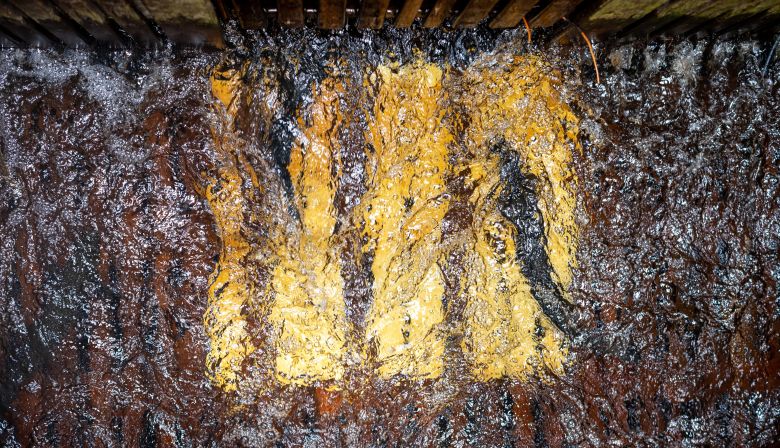
I set about my task, capturing the natural splendor of the falls and the surrounding area, clambering over rocks to nail the perfect angle and composition. That was until Don approached me. “Enough of this,” he said. “We’re here to tag some fish, and I believe you’re yet to catch a Newfoundland salmon. Let’s head down to the Spring Pool and see if we can get you some fish while we wait for Kris and John to fetch DFO.”
Spring Pool on the Terra Nova is ideal salmon habitat. The river flows down from the waterfall through a narrow channel before opening up to a wide pool, featuring an eddy on one side and a trough on the other. I hustled to snap a few shots before assembling my rod.
Don kindly offered to guide me, as regulations require non-residents to always have a guide with them while fishing on scheduled salmon rivers. I attached an undertaker to my line and commenced fishing. Having learned the art of fly fishing on Maine’s trout rivers, I often cast more directly across the current than at a 45° angle downstream while swinging a wet fly—a habit Don was quick to notice.
He pulled me aside and suggested I cast further downstream. But he had a little trick up his sleeve that I hadn’t yet encountered: the riffle hitch. I’d heard of this technique but hadn’t tried it out before. Don demonstrated how to tie the knot according to the side of the river you’re fishing and then how to maintain a high rod tip as you gradually strip the fly across the seams between fast and slow water. The action was deeply satisfying, reminiscent of dry fly fishing for trout. The anticipation of seeing a fish leap and hit my swiftly moving fly was electric.
Yet, my first Newfoundland salmon remained elusive. I worked the pool for a good hour, heeding Don’s guidance, but to no avail. When DFO scientist Curtis Pennell and local volunteer, Derek Sparkes, arrived, I decided to cede my spot in the pool—given my streak of bad luck—and join the gathering on the bank for some banter.
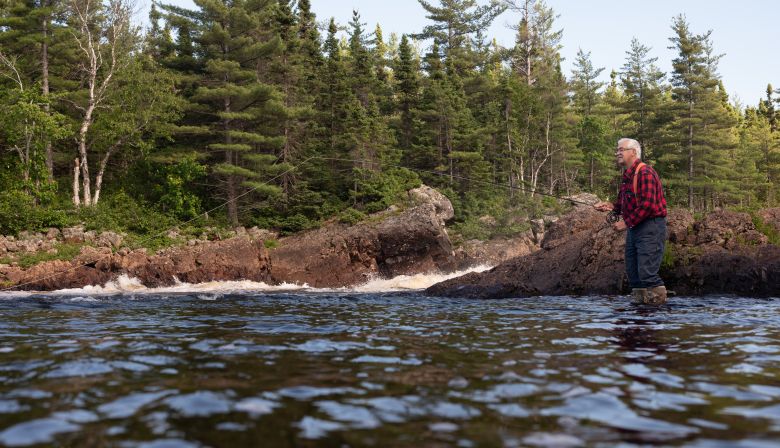
Before long, John Lane hooked a fine four-and-a-half-pound grilse. He made quick work of it, brought it to the shore, and the team sprang into action. The fish was secured, submerged in cold water, sedated, and in no time, the tag was inserted. It was then released to continue its journey, destined to furnish us with invaluable data on fish migration patterns throughout the watershed.
After the flurry of activity, John strolled over and suggested I take a few flicks with his rod. Several fish had recently shown further down the pool, where he had hooked his grilse. He thought I should try my luck with his white blue charm.
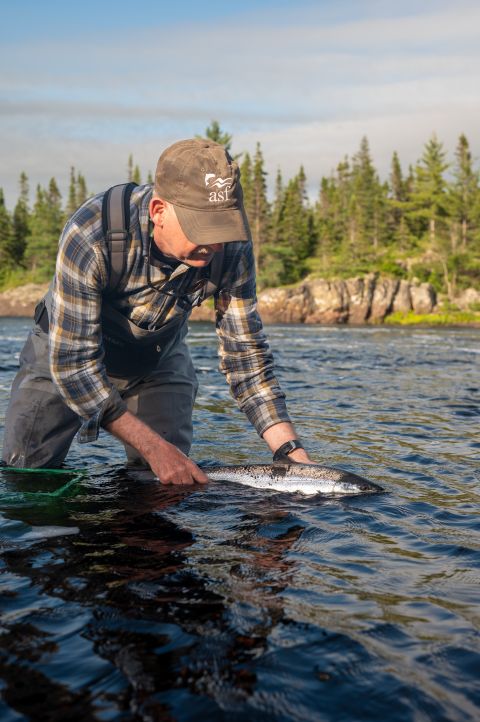
The evening was enchanting, and the sun’s rays skimmed across the water at a pleasing angle. The V curve from the fly cast an alluring shadow. I could have continued casting there all night, lost in the rhythmic dance. Finally, I cast just into the nearby seam behind a large rock about 40 feet away, and boom—my first strike in Newfoundland. It was astounding. The salmon surged out of the water in pursuit of the blue-and-white lure and darted downstream. As I reached for my line to get the fish on the reel, I realized I wasn’t using my rod. John’s rig was set up for a right-hand return. It was just a moment later that the fish seemed to sense my unpreparedness, casting the fly back at me in a display of contempt.
The quads were in use so Don, Kris, John L, and I had to make the hour-long trek back to the boats on foot. However, far from being upset, I was rather pleased by the situation. Spending time with these individuals has always been enriching for me.
Don, with his immense knowledge of salmon conservation history in Newfoundland, is like a walking encyclopedia. On the other hand, Kris is someone I’ve come to deeply admire for his visionary approach and unwavering commitment to our WSW program. Being able to quiz these two for an hour is not only a delight but is also immensely beneficial to my quest to understand more about the complexities surrounding the conservation of wild Atlantic salmon.
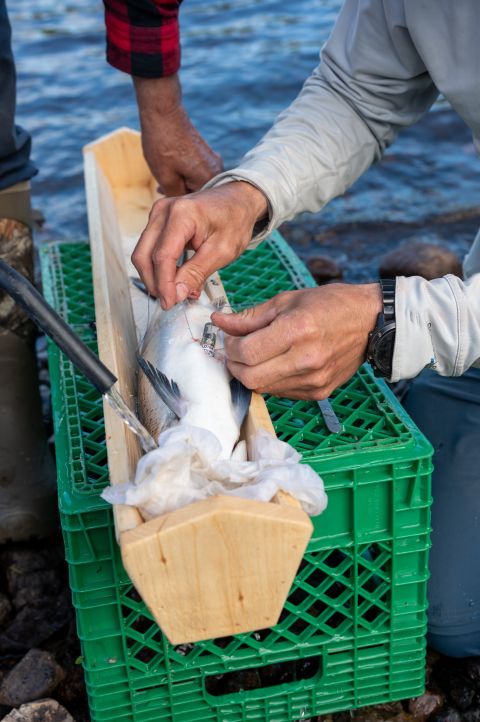
The next day, just as the sun graced the morning sky, we convened in the parking lot of a Mary Brown’s along Route 1, near the junction where the highway traverses the Terra Nova River. Eight of us assembled—six who were partaking in the canoe trip and two tasked with shuttling the trucks across the arduous two-hour journey to the endpoint of our float. This meeting marked my first encounter with Shane Frost, FABEC board member, and Devon Bath, summer research project manager.
As we set off towards our put in location, I was privileged to endure the long, bumpy ride with Devon and John B, during which Devon spoke about his love for science and conservation. His research on the predator-prey dynamics of cod—specifically, size-selective mortality by fish predators—was intriguing. In simpler terms, he investigated why larger fish typically escape predators and the conditions that encourage rapid growth in fish populations. This research carries significant implications for the year-to-year recruitment of adult fish. In addition to his scientific pursuits, Devin’s entrepreneurial spirit led him to explore interests like portrait and landscape photography—a skill set that promised to be invaluable as he begins managing FABEC’s social media accounts.
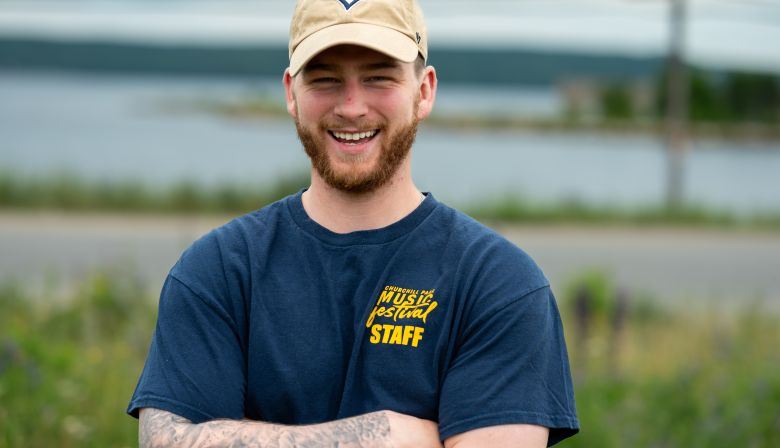
Devon’s ardor for the natural world was palpable as he continued and expertly spoke about his interest in some of the challenges facing salmon. He displayed particular interest in genetics and the genetic plasticity of hatchery versus non-hatchery fish. According to Devon, the homogenization of genetics, a common outcome of hatchery programs, prevents local genetic adaptation to watersheds and can result in lower fish returns over time.
Our expedition would lead us down the river stretch between Lake St. John and Terra Nova Lake. The estimated 30km journey encompassed meandering ponds and rapids, the magnificent Mollyguajeck Lake, and a series of awe-inspiring waterfalls.
Shane and I paired off in one boat, with John and Devon in another, and Kris and Matt navigating the final vessel. Being partnered with Shane—a local moose hunting and fishing guide—proved fortuitous as he skillfully navigated the river’s complex network of rapids and ponds.
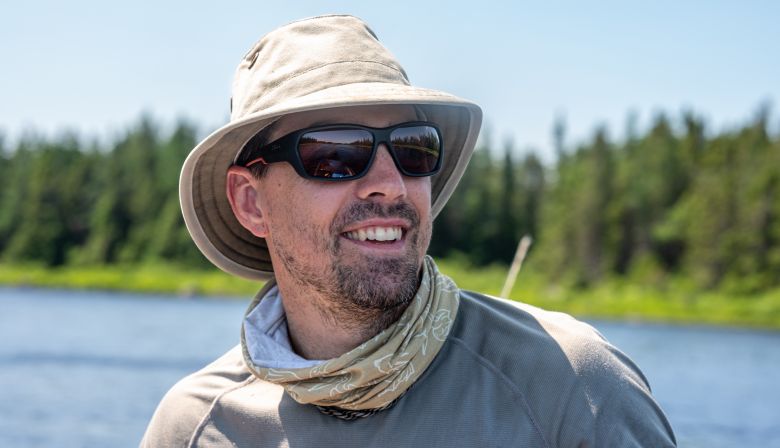
Shane immediately captured my interest with an observation: “It’s so great that people who have done things a thousand times still do them wrong out of excitement.” He’d spotted my fly line running backwards through the tip of my rod, adding unnecessary difficulty to my casting—a mistake he was quick to correct.
In response to my question about the most effective fly to use, Shane confidently suggested the Royal Coachman or White Wulff. He added that, in Newfoundland, brook trout only strike at moving flies, another concept that felt counterintuitive to the trout angler in me, who has been trained to rely on still and lengthy dry fly drifts.
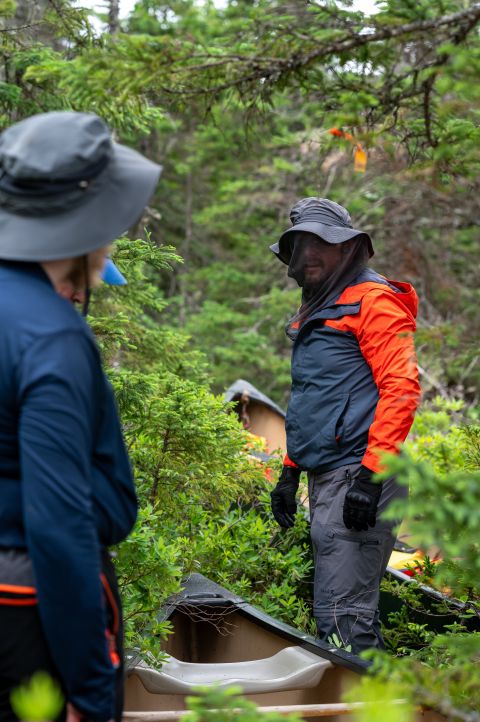
Shane’s deep-rooted understanding of the river was nothing short of remarkable. His keen knowledge allowed him to pinpoint precisely where various species and sizes of fish were likely to be found. At one point, he directed me towards a tail-out where I could have blissfully spent an entire day catching 1lb brook trout, cast after cast, which is exactly what I did for an enthralling hour.
Later, as we continued our float, Shane led me to an ideal salmon pool. Under his expert guidance, I managed to reel in my first Ouananiche, a Newfoundland landlocked salmon. This significant moment was a testament to Shane’s intuitive understanding of the river, a skillset that only comes with years of attentive experience and a genuine passion for the outdoors.
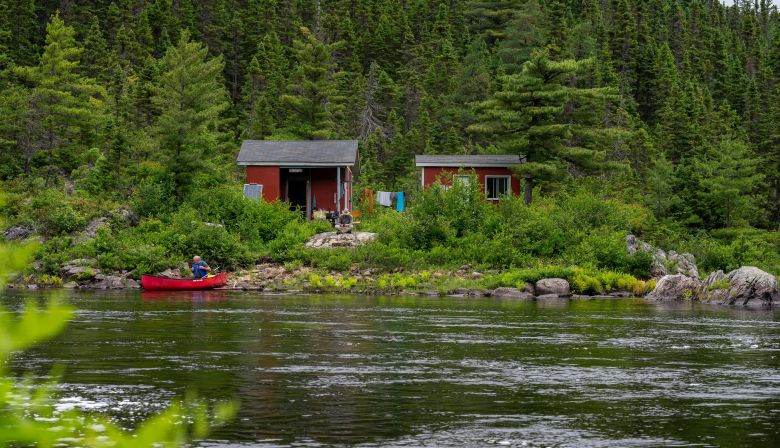
The abundance of salmon in the Terra Nova is just one of the reasons why it makes for an ideal candidate for our Wild Salmon Watersheds program. The area has energetic and passionate individuals invested in conservation efforts and a watershed that can be sustained with a variety of protection and improvement measures.
The Wild Salmon Watersheds initiative focuses on small, consistent steps that steadily and assuredly benefit wild Atlantic salmon populations. In baseball terms, it’s about hitting singles, steadily progressing, rather than swinging for home runs, aiming for grand, immediate changes. And with the attributes the Terra Nova presents, it’s safe to say it’s got a winning lineup.
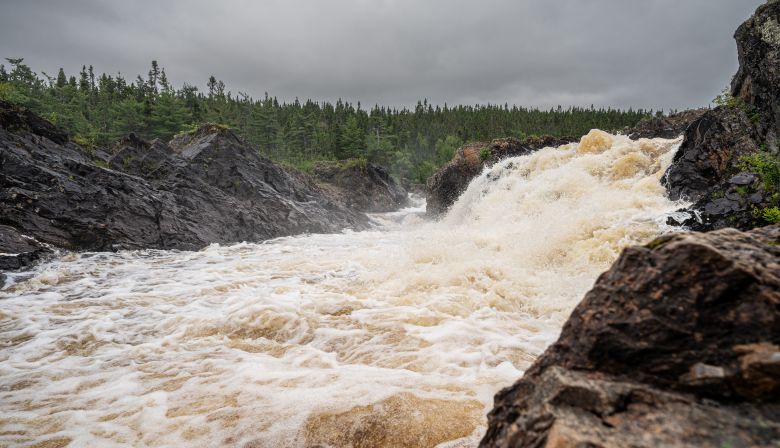
ASF’s initiative is a fresh, sustainable approach to conservation, an approach that becomes increasingly pertinent as we grapple with climate change. This initiative doesn’t only seek to restore damaged habitats but also proactively aims to protect thriving populations.
It is based on a simple, powerful philosophy: empowering local partners with the knowledge, resources, and confidence to implement long-term sustainable conservation projects. ASF is committed to offering continual support and resources to non-profit and Indigenous organizations. This enables these organizations to focus on their broader environmental and community wellness objectives.
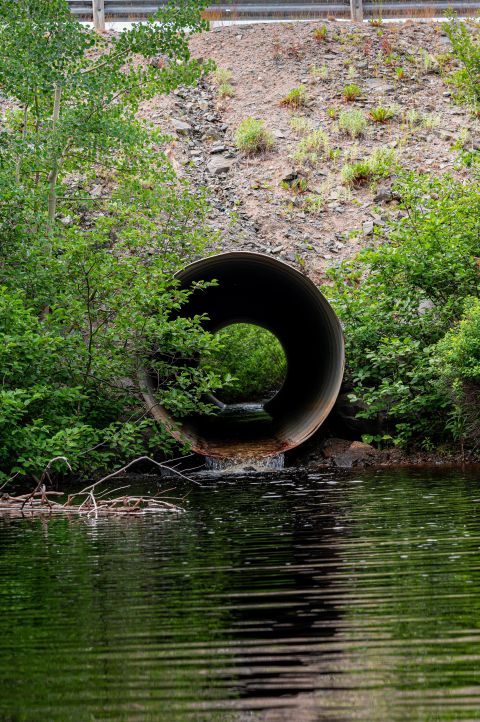
The partners in this initiative are invaluable; they are custodians of traditional and local knowledge, advocates for conservation, and active participants in the preservation work. ASF’s support will be ongoing, but the ultimate goal is for each Wild Salmon Watershed to maintain a self-sufficient, dynamic team of conservation volunteers and professionals. This ensures the preservation of salmon populations and promotes long-term environmental stewardship. The Terra Nova River, with its abundant salmon population and passionate community, holds immense potential for inclusion in ASF’s groundbreaking Wild Salmon Watersheds program.
With a renewed sense of purpose and a head full of learnings, I’m now ready to continue my journey. As the sun sets on another fruitful day, the allure of Newfoundland’s west coast grows stronger. My adventures and encounters, as varied and vibrant as the land itself, are yet to unfold.
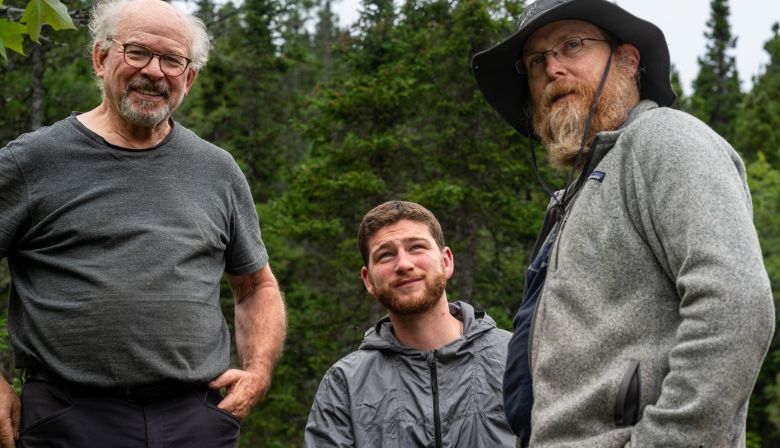
Thank you for being part of the Rivernotes community and for tuning in each week as I traverse the stunning and rugged landscapes of salmon country. The next pit stop is on the Exploits and then the mighty Humber River, a fly fishing paradise. As always, I encourage you to share the Rivernotes blog with like-minded friends. Each shared story and gift given become a ripple that can initiate a wave of change.
Should you find delight in the stories and visuals we’re sharing this season, we kindly invite you to consider making a donation here to ASF.
In return for your generous contribution, you will be eligible to receive high quality digital copies any of the captivating images I capture in the field this summer. If you wish to reach out for more details, or just to connect, feel free to email me at Pdore@asf.ca, or Cindy at Cbartlett@asf.ca. Your support greatly contributes to our mission and is deeply appreciated.
Until next week, stay sharp, and tight lines!
Peter

Growing up, my passion was always the great outdoors – I spent countless hours exploring, chasing after snakes, bugs, and frogs. I was fascinated by the world of animals and insects and was always eager to learn more. This curiosity led me to a profound interest in environmental conservation, a cause my mother strongly championed.
At the age of 12, I decided to become a marine biologist, eager to contribute to the protection of our oceans’ biodiversity. Memorial University (MUN), known for its strong ocean sciences program, was my university of choice, partly due to family ties in Newfoundland.
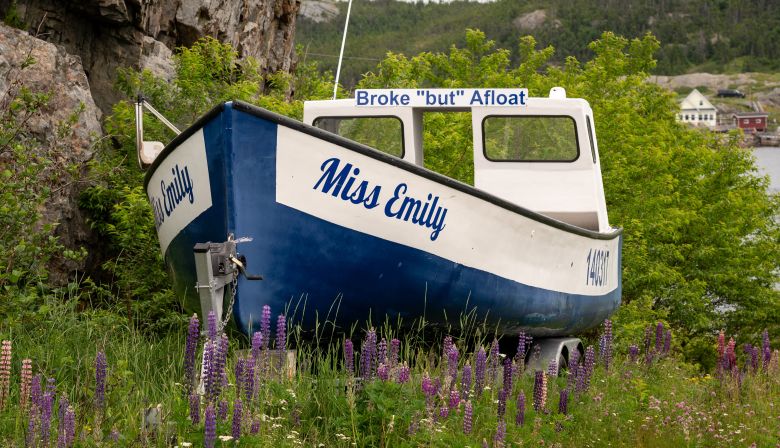
During my BSc in Marine Biology, I engaged in five separate research projects, winning a MUN award for my honors thesis and publishing a research paper with two more in the pipeline. My connection with John Baird through a MUN professor led to my involvement with the passionate salmon conservation group, FABEC, in 2023.
Joining FABEC reminded me of my original drive to be a marine biologist: to conserve our natural world. Being a part of a community that deeply cares for the Terra Nova River and its salmon has been a unique and rewarding experience that fuels my commitment every day.
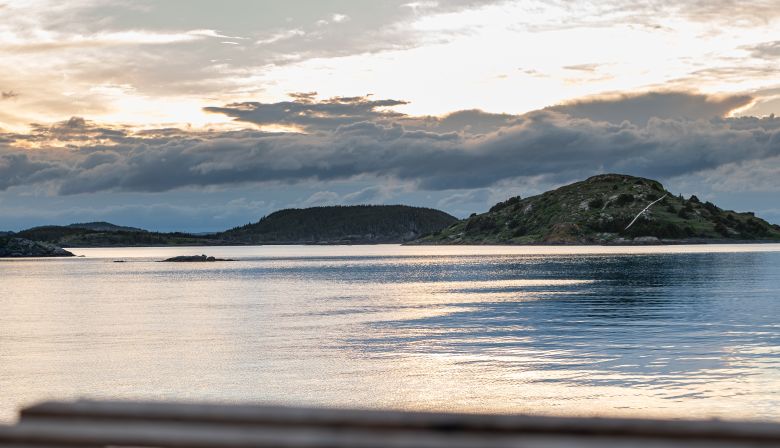
My journey to becoming a passionate fly fisher began at a young age when I was drawn to the allure of the local streams, initiating a lifelong love for trout fishing. This fascination blossomed into an obsession, leading me to uncover every potential fishing spot within a 30-mile radius of my home—a feat that still fills me with immense pride.
As I matured, my attention shifted towards the angling community. I found joy in aiding fellow fishermen—whether it was to sharpen their techniques, provide insights about their target species, or enlighten them about the nuances of our local rivers. It was clear to me that education was key for sustainability.
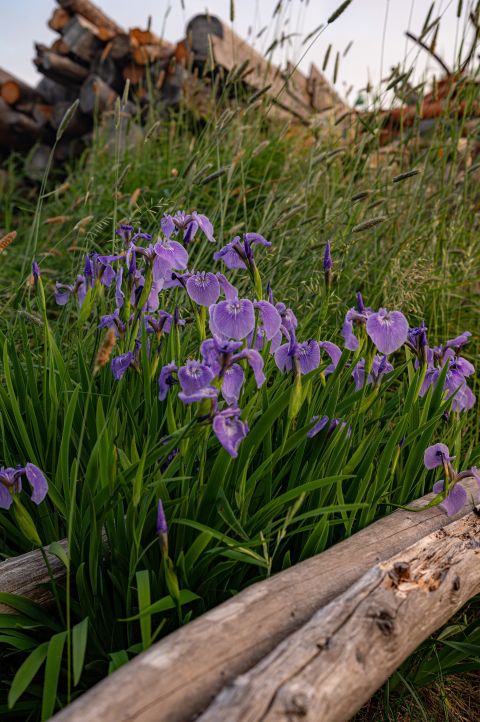
This realization sparked my unwavering belief: our fishing privileges hinge on our respect and care for these limited resources. Consequently, this perspective led me to join the ranks of FABEC, a local organization committed to the conservation of salmonids. Within FABEC, my primary mission is to implement protective measures on sensitive areas of our local rivers. These areas serve as refuges for a significant number of fish, particularly when river conditions become unfavorable.
Though our strides have been smaller than desired, my resolve remains unfaltering. I am committed to championing our cause to the public and advocating for responsible fishing practices. Above all, I aim to safeguard the very essence of fishing, an activity that has granted me unparalleled joy throughout my life.

It’s been a hot, humid few weeks with little reprieve from the heat as overnight lows range from 18 to 25 C . Fisheries and Oceans Canada (DFO) met with stakeholders, including ASF, yesterday morning respecting the Margaree Warm Water Protocol. This was our first meeting of the 2023 season as the 20-degree threshold had just been reached. All partners agreed with the closure of Sections 1 and 3 of the Margaree River to all angling effective July 19th at 4:00pm. Please refer to Variation Order MAR-VAR-2023-077 – Maritimes Orders Registry (dfo-mpo.gc.ca)
For some background, after a heatwave in 2018, a special meeting was held on the Margaree River that resulted in a large section of the watershed being closed to angling. Studies show that mortality rates in Atlantic salmon exercised to exhaustion increase when the daily minimum water temps climb above 20C. DFO subsequently partnered with the Nova Scotia Inland Fisheries, Margaree Salmon Association, Atlantic Salmon Federation and Nova Scotia Salmon Association to develop rules for angling in environmentally stressful conditions. The Warm Water Protocol resulted, and the updated version may be accessed here.
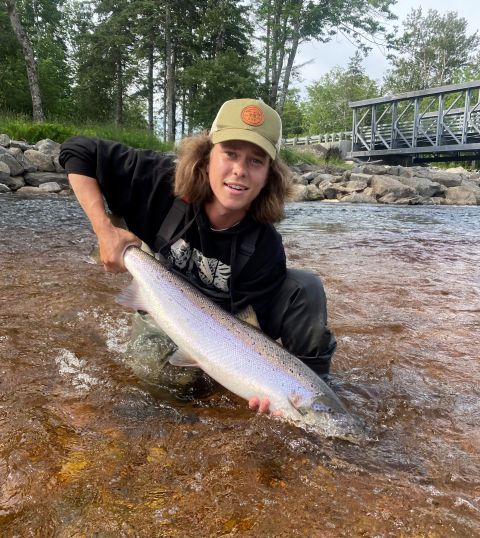
Charles Cusson, Quebec Program Director, Reports:
La mi-saison approche rapidement et nous n’avons pas le choix d’admettre qu’en général, la montaison 2023 est décevante. D’après les bilans saumon de 2017-2018, les périodes de reproductions suivant les retours de ces deux saisons nous portaient à croire une meilleure performance pour la saison 2023.
En 2017, 25 836 saumons adultes ont été dénombrés dans les 38 rivières à saumon pour lesquelles des décomptes ont été effectués. En 2018, 22 232 saumons adultes ont été dénombrés dans 39 rivières.
À moins d’un miracle d’ici le 31 juillet, nous allons débattre les différentes raisons possibles pendant les prochains mois qui pourraient expliquer ce que nous vivons cet été. Le questionnement dont plusieurs gestionnaires et pêcheurs se demandent est le manque substantiel de madeleineaux.
Entretemps, quelques rivières, telle la Bonaventure et, ont récemment publié des résultats de pêche sportive au 30 juin comme il avait déclaré au début de la saison. Nous attendons des données pour les rivières York, Dartmouth, Saint-Jean et Cascapédia.
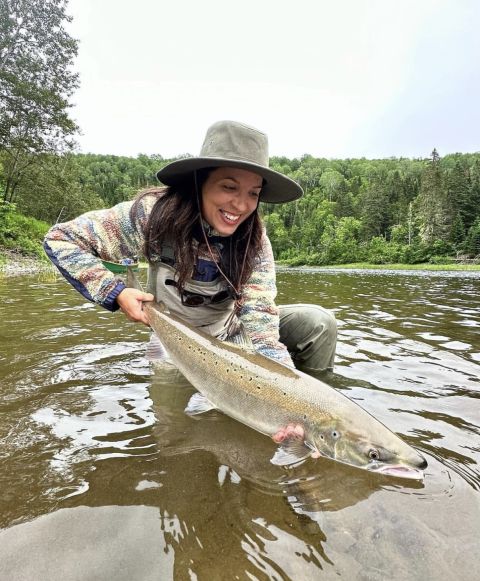
The mid-season point is fast approaching, and we have no choice but to admit that the overall 2023 run is disappointing. According to the salmon reports for 2017-2018, the returns from these two seasons led us to believe a better outcome was in store for the 2023 season.
In 2017, 25,836 adult salmon were counted in the 38 salmon rivers for which assessments were made and in 2018, 22,232 adult salmon were counted in 39 rivers.
Unless there is an incredible turnaround by July 31, we will be discussing the various possible reasons which could explain what we are experiencing this summer. The question that many managers and fishers are wondering about is the substantial lack of grilse to date.
Meanwhile, a few rivers, such as the Bonaventure, have recently released sport fishing results as of June 30 as they announced at the start of the season. We are awaiting data for the York, Dartmouth, Saint-Jean and Cascapédia rivers.
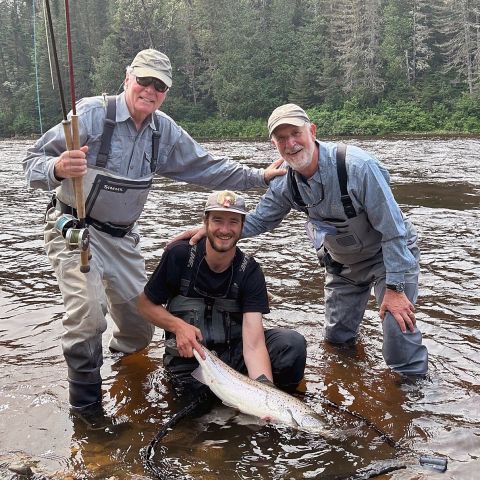
Don Ivany, Newfoundland and Labrador Program Director, Reports:
Newfoundland and Labrador have experienced extremely hot weather over the past week, with temperatures hitting highs of 35 degrees Celsius in some areas. This has caused water temperatures to rise in all rivers across the province, resulting in noticeably slow fishing.
Fishing has been particularly challenging on rivers where there was a decent number of fish last week, such as those in central Newfoundland. The unusually warm water temperatures make it difficult to attract fish to the fly. Similarly, reports suggest there was a scarcity of fish in some rivers last week, particularly on the Northern Peninsula and in Southern Labrador.
Current water temperatures in our rivers average about 20-24 degrees Celsius. The water levels range from low to medium. The forecast suggests a gradual decrease in air temperatures over the next week, along with rain across many areas of the province. Therefore, we anticipate an improvement in fishing conditions over the coming week.
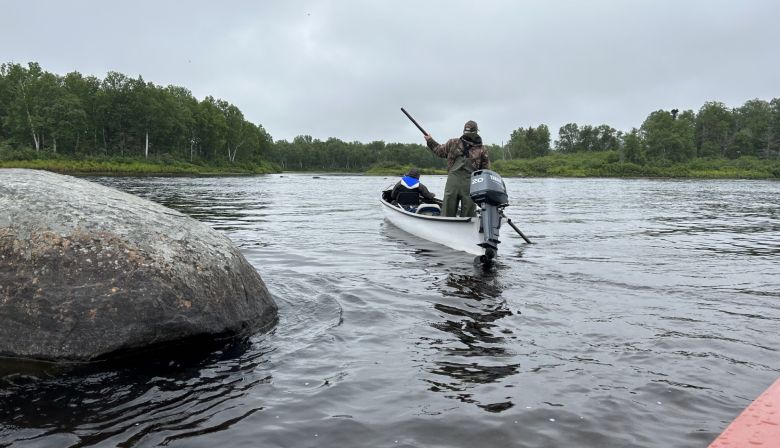
Labrador Dwight Lethbridge, the owner of Pratt Falls Lodge on the Eagle River, says fishing was very slow last week due to the high water temperatures. On the bright side, he reports seeing large numbers of salmon in the river’s estuary, presumably waiting for cooler water temperatures before swimming upstream.
SPAWN member Kris Manuel reports slow fishing on the Forteau River due to warm and low water. However, a few fish were spotted on the Pinware River, despite the challenging conditions.
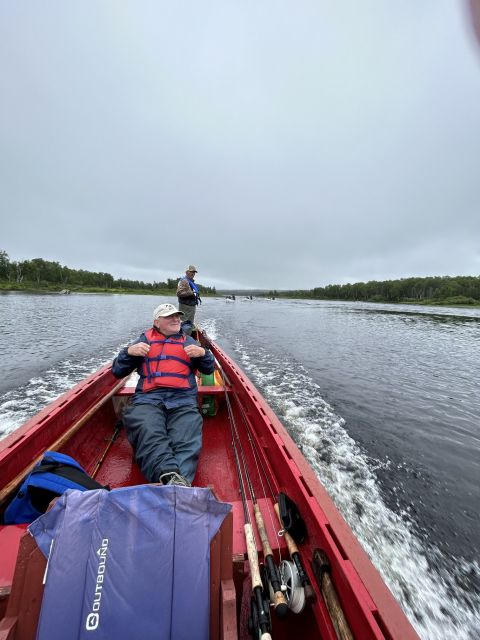
Northern Peninsula – Both Kris Manuel and Craig Purchase report poor fishing conditions and a scarcity of fish in the Big East River, Main Brook (Roddickton), Beaver Brook, and lower Castor River, respectively. Both attribute these conditions to the warm and low waters.
Western Newfoundland – Fishing was slow on the upper Humber River due to warm water and a lack of new fish. However, the lower Humber River and Harry’s River showed signs of improvement with sightings of large fish.
Central Newfoundland – Despite the heat, anglers have reported catching a few fish on the Exploits River. The Gander and Terra Nova Rivers, however, experienced slow fishing due to warm and low water levels.
Southwest Coast – Despite good water levels, the warm temperatures slowed down fishing activity on the Southwest Coast.
Avalon Peninsula – Fishing was slow on the Avalon Peninsula due to warm and low water levels.
We remain hopeful that the forecasted rain and cooler temperatures will improve fishing conditions across the province in the coming week.
Jeff Reardon, Maine Project Manager, Reports:
Following last week’s mobilization for the Danforth fishway on Baskahegan Stream, Sargent Corporation mobilized on July 17 to take on a total of 13 stream crossings on logging roads on the Appalachian Mountain Club’s 100,000-acre Maine Woods Preserve. Sargent hit the ground running. By mid-morning on July 18, Sargent had already set the footers for the first crossing and was expecting to finish the footers on the second crossing on Tuesday.
These crossings—and 12 more to be completed in 2024—represent the late stages of AMC’s impressive effort to make its entire logging road network meet “Stream-Smart” standards. That means the stream crossings will not obstruct passage for fish or other aquatic or stream-associated organisms, will pass flows including large floods, and will allow for natural stream processes to occur above, below, and through them. At the same time, these crossings will be more resilient to flooding and other natural disturbances, avoiding expensive and dangerous failures during storm events to provide a more reliable road network for logging trucks as well as guests at AMC’s three lodges and members of the public who have open access to AMC’s lands and waters.
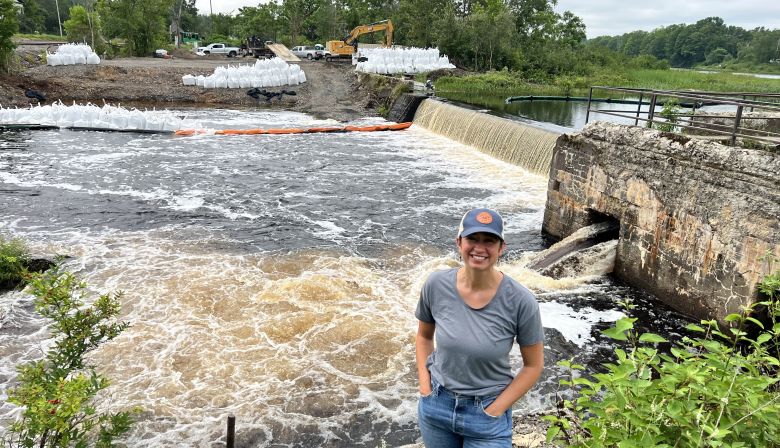
Combined, these crossings will restore access to almost 8 miles of headwater habitat for Atlantic salmon and other native fish. Just as importantly, in combination with AMC’s previous work lower in the watershed, these projects will make all the stream crossings on AMC’s lands in the Middle Branch and West Branch of the Pleasant River watershed open for fish. The Pleasant River—and the Piscataquis River into which it flows—are open all the way to the Penobscot, where dam removals at Great Works Dam (2012) and Veazie Dam (2013) and the construction of the bypass channel around the Howland Dam at the mouth of the Piscataquis (2015).
ASF’s Headwaters Project now focuses on working with partners to improve access to the headwater streams that are so critical to salmon and other sea-run fish.

Rivernotes Contributor, Chris Buckley, Reports:
Greetings from the enchanted banks of the Alta River in Norway, a realm renowned for being the home of the world’s largest Atlantic salmon, and a coveted destination for fly fishing enthusiasts globally.
Having just spent a remarkable two weeks on the Alta, I am thrilled to share my experiences, punctuated by the good fortune that the river generously bestows upon its visitors, despite this season’s unusually low water levels.
As aficionados will know, the Alta is open to international anglers for three early weeks in the heart of summer: the last week of June, fondly referred to as ‘Week 1’, and the first two weeks of July, known collectively as ‘Weeks 2 and 3’. Each week sees 10 rods gracing the river, casting their lines in hope of landing one of the river’s titan salmon.
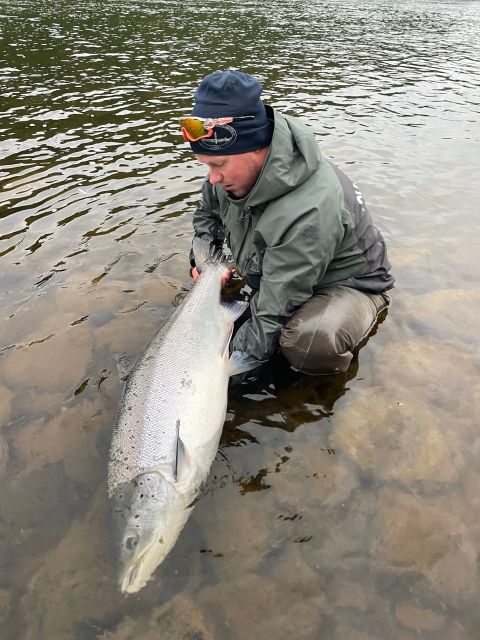
This year, Week 1 witnessed the capture and release of between 90 to 100 salmon, excluding grilse. Among these were three or four impressive catches exceeding 40 pounds. The bounty of Week 2 was even more plentiful, with 127 salmon caught. This haul included a magnificent salmon over 50 pounds and four more hefty fish over 40 pounds. As for Week 3, approximately 120 salmon were caught, of which two tipped the scales over 50 pounds, and at least three others weighed in over 40 pounds.
For visual testimony of these catches, I’ve attached two photos. The first captures the triumphant moment of Nick Zoll from England with his 53-pound beauty, still in the net. The second photograph showcases Mark Birkbeck of Scotland with his spectacular 51-pound salmon. It’s noteworthy to add that all salmon caught by the international anglers are released back into the river, honoring our shared commitment to conservation.
This has been an extraordinary summer at the Alta, and I hope you’ve enjoyed this peek into the river’s abundance. Should you desire further details or have any questions, do not hesitate to reach out. Here’s to the pursuit of the majestic Atlantic salmon, and to the promise of many more successful seasons on the enchanting Alta River.
